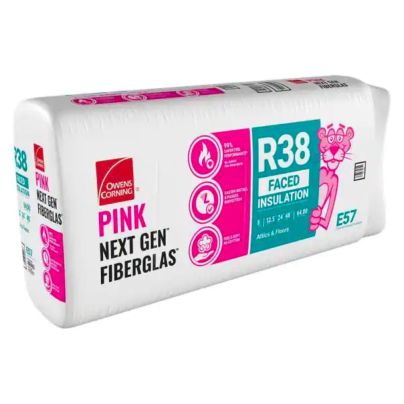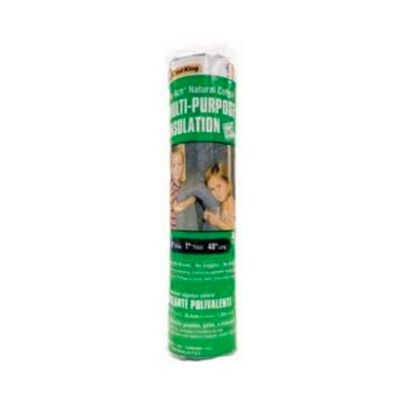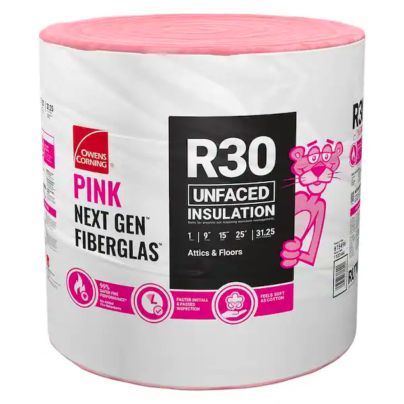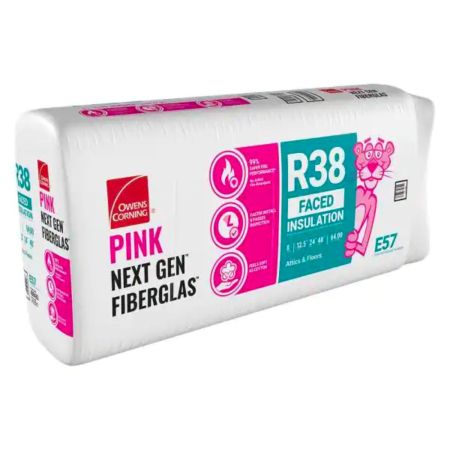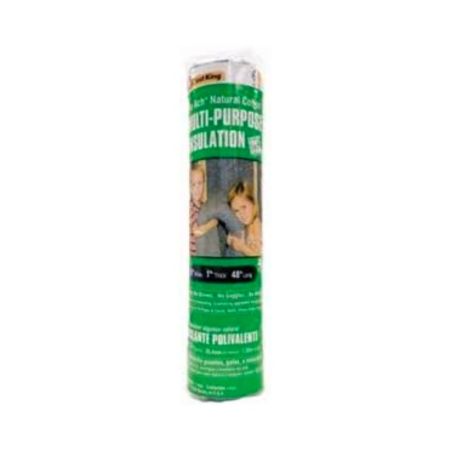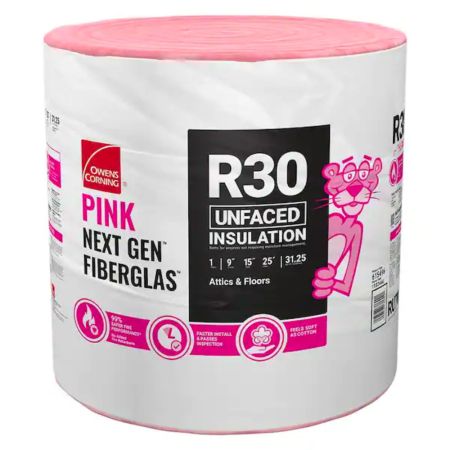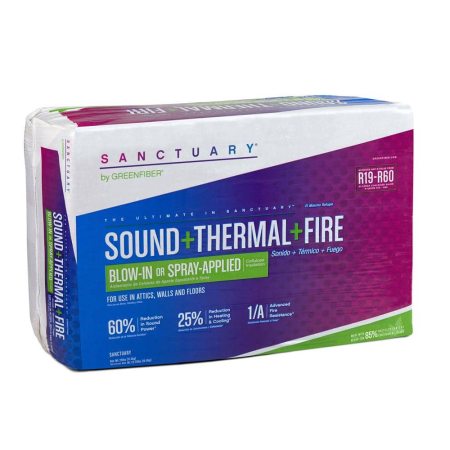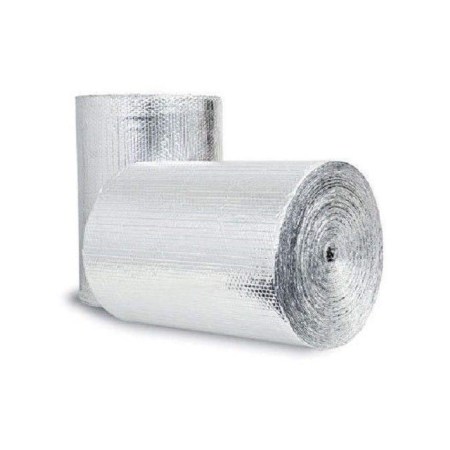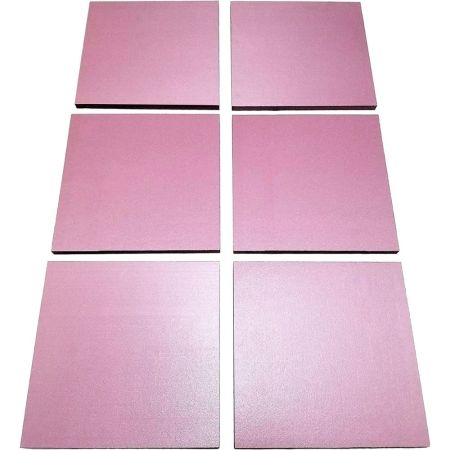We may earn revenue from the products available on this page and participate in affiliate programs. Learn More ›
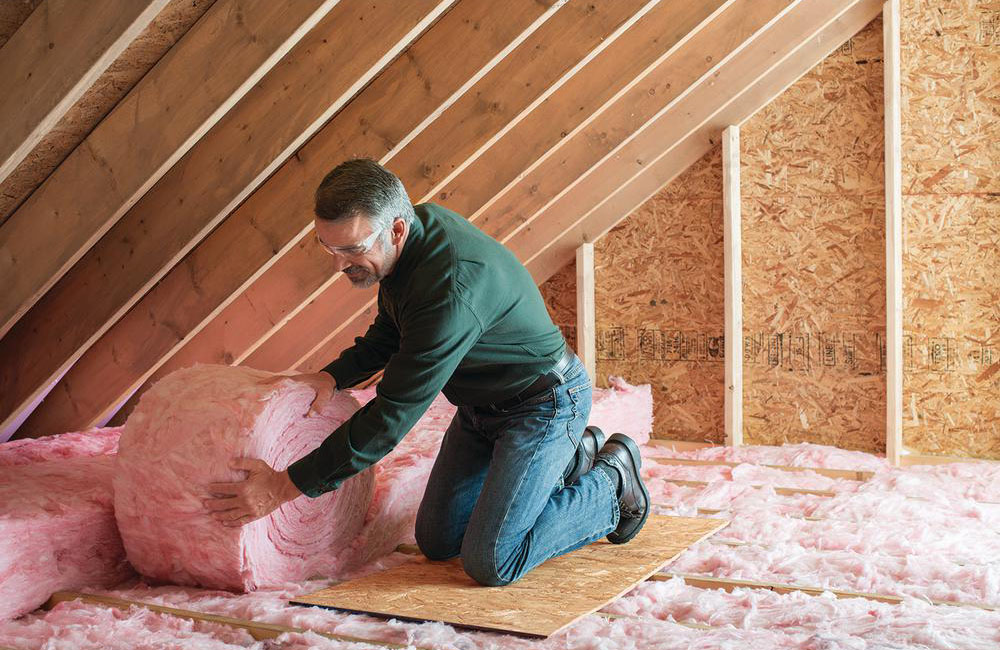
Insulating your attic is an excellent way to protect your home from temperature extremes and moisture damage while reducing heating and cooling costs. Insulation acts as a barrier to prevent the transfer of heat flow from the inside to the outside of the house in winter or from the outside to the inside in summer.
An experienced DIYer can install most types of insulation but some should consider hiring a professional. Gaps in insulation can quickly reduce its effectiveness. Read on for some tips and types of insulation as well as the best options currently on the market.
- BEST OVERALL: Owens Corning R-38 Kraft Faced Fiberglass Insulation
- BEST BANG FOR THE BUCK: Frost King CF1 “No Itch” Natural Cotton Insulation
- BEST BLANKET: Owens Corning R-30 EcoTouch Fiberglass Insulation
- BEST BLOWN-IN: Greenfiber 25 lbs. Cellulose Blown-In Insulation
- BEST RADIANT FOIL: US Energy Products Double Bubble Foil Insulation
- BEST FOAM BOARD: Owens Corning Pink Insulation Foam 1/2″ Thick
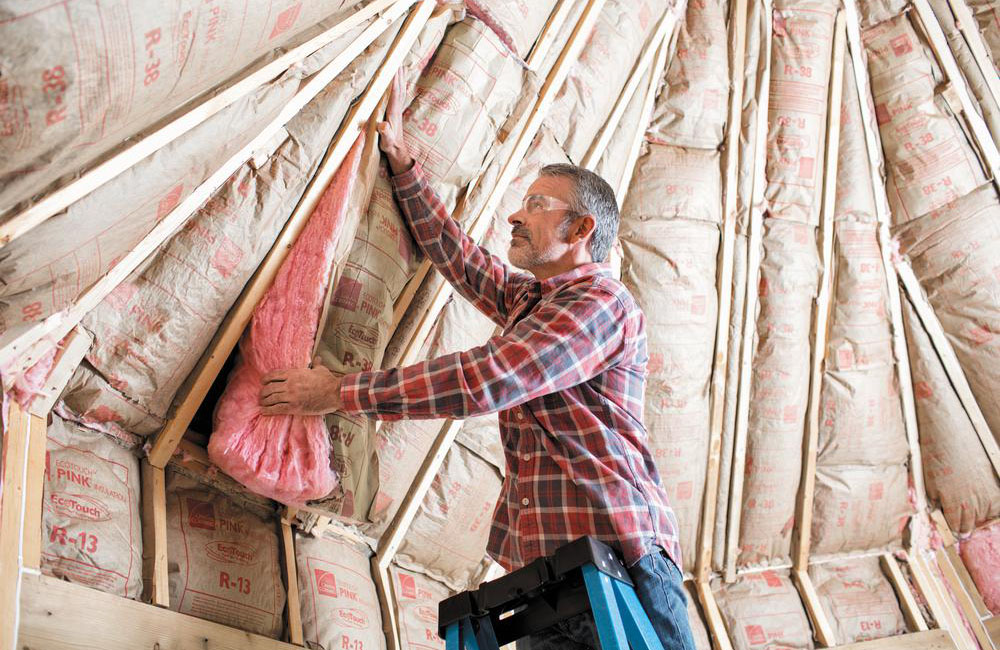
Before You Buy Attic Insulation
In most circumstances, it makes sense to add attic insulation. However, in a few situations, installing insulation can cause serious problems, such as in older homes that were built with large gaps between the walls to account for the moisture that naturally leaks into homes. The gaps allow the moisture to dry without causing damage to the structure, but if these spaces are filled with insulation, it can absorb the moisture and lead to mold and rotted wood.
If you have an old or wood-shingled roof and you attempt to install insulation on the ceiling of your attic, a similar situation could occur. These older roofing materials were made to get wet, breathe, and dry, but with insulation blocking the wood, the moisture will only accumulate. Also avoid using insulation anywhere near knob and tube wiring, which is an outdated electrical system that’s a major fire risk and should be replaced as soon as possible.
Types of Attic Insulation
Several different types of attic insulation are available, including blanket, spray foam, radiant foil, and foam boards, each with benefits and shortcomings.
Blanket Insulation
Blanket insulation is one of the most common types of insulation for walls and attic floors; however, don’t use it in open spaces because the fiberglass particles can affect the air quality in your home. Cut the thick pieces of insulation to fit tightly between the gaps in wooden frames or around pipes, wires, and other obstacles.
While this insulation is also one of the most inexpensive and easiest types to install, it isn’t as effective as spray foam insulation. When installing blanket insulation, wear a breathing mask and protective gloves so it can’t irritate your lungs and skin.
Spray Foam
Spray foam insulation is the primary type of attic insulation. Pair it with blanket insulation to better insulate edges and corners, and use it to seal gaps in existing walls. The most expensive type, it can be a hassle to remove; however, it’s the most effective option for insulating your home against the transmission of hot and cold air.
The spray foam is made of liquid polyurethane, which, when sprayed into the cavity of your wall or attic, expands and hardens into a solid foam. If you haven’t used spray foam before, consider hiring a professional to install it to ensure your home is adequately protected.
Blow-In
Blown-in insulation refers to blowing or spraying insulation products into wall cavities, attics, and floors. Methods vary depending on the form of insulation selected. Two of the most common types of blow-in insulation are fiberglass, rock wool, and cellulose which are applied in an attic space with a blowing machine for easy, even distribution.
Conveniently, most blown-in options can be applied over existing insulation and fills between existing wall studs and ceiling joists for increased insulation.
Radiant Foil
Because it’s designed primarily to reflect heat away from your home, radiant foil insulation is more common in warmer climates. It works through its reflective foil barrier, which is attached to kraft paper or polyethylene bubbles. The bubbles help prevent the transfer of heat through the barrier because they provide a pocket of air, which reduces the rate that heat can move through the substance.
While standard insulation reduces the flow of heat, radiant foil reflects it. Because of this difference, radiant foil cannot be measured using the same factors attributed to blanket, spray, or foam board insulation. Radiant foil usually is the most affordable type of insulation.
Foam Boards
Low in cost and easy to install, foam board insulation is generally made of polyurethane, polystyrene, or polyisocyanurate. Sheets of foam board can be cut to fit tightly between wall studs or attic ceiling joists. Because they are not as effective at insulating, foam boards are not as popular as blanket insulation.
However, foam boards don’t cause moisture accumulation and mold growth as can blanket insulation, because the solid foam doesn’t absorb a lot of moisture. Instead, it dries in a relatively quick time frame.
What to Consider When Choosing the Best Attic Insulation
Finding the proper attic insulation for your home isn’t difficult once you’ve determined which type of insulation to purchase. However, there are other factors to consider, including the R-value and material.
R-Value
Attic insulation ranges in effectiveness, so to help people find the best attic insulation for their homes, manufacturers and industry professionals typically reference insulation’s R-value. R-value is a measurement of insulation’s resistance to the flow of heat. The higher the R-value rating of a product, the more effective it is at reducing energy costs in your home.
R-value is usually listed in the product description or on the product packaging. However, radiant foil insulation isn’t measured by R-value because it’s designed to reflect heat instead of reducing the transmission of heat. The optimal R-value for the insulation in your home also depends on your geographic location. Review this Energy Star R-value chart to learn the estimated R-value for your geographic region.
Material
Attic insulation can be constructed from a wide range of materials, including cellulose, fiberglass, mineral wool, liquid polyurethane, and polystyrene.
- Cellulose insulation was used regularly in buildings for most of the last 100 years. This insulation material consists of cellulosic fibers like newspaper, cardboard, cotton, straw, hemp, and sawdust. At just 3.8 per inch of cellulose insulation, the R-value is relatively low.
- Fiberglass insulation is made from tightly woven fibers that are light, malleable, and relatively simple to cut and install. This material is regularly used in blanket insulation and has an R-value of 2.7 per inch.
- Mineral wool has an R-value of 3.3 per inch. It’s a stone-based mineral fiber insulation material that contains basalt rock and recycled steel slag.
- Liquid polyurethane is the main ingredient in spray foam insulation. The R-value of this type of insulation ranges from 3.5 per inch to 6.5 per inch, depending on whether you’re using open-cell (3.5) or closed-cell (6.5) spray foam.
- Polystyrene is used to create foam board insulation with a variable R-value of 3.8 per inch to 5 per inch, depending on whether it’s expanded polystyrene (styrofoam) or extruded polystyrene, which can be identified by the blue or pink color.
- Cotton is a very reliable insulation material for your attic and it is commonly made with recycled materials and is very easy to cut and install. This material is also safer than fiberglass during installation and use as there are less fibers floating around.
Our Top Picks
The top-rated products below were chosen for their quality, price, and customer satisfaction to help you find the best attic insulation to protect your home from high- and low-temperature extremes.
Best Overall
Owens Corning R-38 Kraft Faced Fiberglass Insulation
See ItInstall this insulation from Owens Corning in an uninsulated attic or add it as a second layer to increase the R-value potential of a home and cut heating and cooling costs. The insulation is made of 35 percent recycled content, and it’s designed to be non-absorbent. As a result, it can resist moisture absorption even in areas that experience higher humidity.
Each of the 4 packages includes eight pieces of fiberglass attic insulation, and each piece measures 4 feet by 2 feet. Using all eight pieces without cutting them covers a 64-square-foot space with 8.25-inch thick insulation. This blanket-style attic insulation is easy to cut and install, and the thick insulating material also helps reduce noise and vibration in your home.
Product Specs
- Type: Blanket
- R-Value: R-38
- Material: Fiberglass
Pros
- Made with 35 percent recycled materials
- Non-absorbent; resists moisture absorption even in higher humidity
- Easy to cut and install
- Covers 64 square-foot spaces per pack
Cons
- Pricey compared to other attic insulation options
- Needs to be covered with a 15-minute thermal barrier
Get the Owens Corning R-38 attic insulation at Lowe’s or The Home Depot.
Best Bang for the Buck
Frost King CF1 u0022No Itchu0022 Natural Cotton Insulation
See ItAffordable and effective, this natural cotton attic insulation by Frost King is 1 inch thick and measures 16 inches by 48 inches. Use one or more pieces of the insulation on attic walls, ceiling, and floors, or cut or rip up smaller pieces of insulation to fill in gaps around pipes, ducts, windows, and doors.
Made with cotton denim that’s resistant to mold, mildew, and fire insulation, this is an all-natural alternative to woven fiberglass. Moreover, natural cotton denim is safe and easy to install with just your hands and a utility knife.
Product Specs
- Type: Blanket
- R-Value: R-4
- Material: Cotton
Pros
- Suitable for attic floors, ceilings, and walls
- Can be cut or ripped safely without wearing gloves or safety glasses
- Can be used around pipes, ducts, windows, and doors
- Resistant to mold, mildew, and fire
Cons
- May not provide ample thermal insulation
Get the Frost King attic insulation at Amazon, Ace Hardware, and The Home Depot.
Best Blanket
Owens Corning R-30 EcoTouch Fiberglass Insulation
See ItThis blanket insulation from Owens Corning is easy to cut, position, and install in almost any space. The woven fiberglass insulation is made with more than 99 percent natural ingredients, including minerals, plant-based compounds, and 65 percent recycled content.
This blanket insulation comes in a 9-inch-thick roll. It boasts an R-value of 30, keeping your home warm in colder months and cooler in the warmer months. The insulation aids in reducing the transmission of noise.
Product Specs
- Type: Blanket
- R-Value: R-30
- Material: Fiberglass
Pros
- Made with 99 percent natural ingredients; 65 percent recycled content
- Easy to cut and position
- Excellent thermal insulation to help regulate heat in every season
- Noise-reducing
Cons
- Pricey, especially if insulating a large area
Get the Owens Corning R-30 attic insulation at The Home Depot or Ace Hardware.
Best Blown-In
Greenfiber 25 lbs. Cellulose Blown-In Insulation
See ItWith versatile application options and an R-value of R-19, the Greenfiber Cellulose Blown-In insulation is a viable option for attics, sidewalls, and ceilings. Whether you spray it on or opt for blow-in application, this insulation is easy to apply over existing insulation or alone and reduces your heating and cooling costs by 20 percent.
This insulation can cover 48 square feet of attic space and is suitable for all climates. It also reduces noise in your home by 60 percent, is made with 85 percent post-consumer paper, and uses low-energy manufacturing. Finally, it has ample fire-resistance and is carbon-locked which makes it long-lasting.
Product Specs
- Type: Blown-in or spray foam
- R-Value: R-19 to R-60
- Material: Cellulose
Pros
- Reduces heating and cooling costs by 20 percent
- Made with 85 percent post-consumer paper using low-energy manufacturing
- Reduces noise by 60 percent
- Reduces fire hazards
Cons
- Some users report unpleasant smell
Get the Greenfiber attic insulation at The Home Depot or Lowe’s.
Best Radiant Foil
US Energy Products Double Bubble Foil Insulation
See ItThis radiant foil attic insulation by US Energy Products is a solid option when paired with another insulating material like foam board or blanket insulation, because radiant foil can reflect up to 97 percent of radiant heat. The secondary insulator resists the flow of the residual heat. This insulation is easy to cut with a utility knife or scissors and simple to install with staples, nails, or an adhesive.
The insulation acts as a sandwich, with two layers of reflective metalized aluminum polyester film on the outside and two layers of polyethylene air bubbles on the inside. The air bubbles reduce the flow of heat, while the foil reflects the radiant heat. This construction keeps homes cool in warmer climates and warm in colder weather.
Product Specs
- Type: Radiant foil
- R-Value: R-1.3
- Material: Aluminum polyester and polyethylene
Pros
- Reflects up to 97 percent of heat
- Suitable for high-heat regions; keeps inside temperature more consistent under varying weather conditions
- Light weight makes it easy to cut and install
Cons
- Should be used with foam board or blanket insulation, which is more effort and cost in the short-term
Get the US Energy insulation on Amazon.
Best Foam Board
Owens Corning Pink Insulation Foam 1/2u0022 Thick
See ItFoam board insulation is rigid and lightweight, making it easy to carry and install on floors, walls, ceilings, and around windows. Use a warm utility knife to slice through this foam board from Owens Corning with a high degree of precision. This method allows users to form the insulation to the exact size requirements or even to cut rounded shapes in the foam board so heat isn’t lost around pipes or other obstructions.
The package includes seven foam boards with an R-rating of 3.0. This insulation is moisture-resistant and ideal for creating a vapor barrier in narrow gaps around windows and doors where significant amounts of heat can be lost from a home in the winter months.
Product Specs
- Type: Foam board
- R-Value: R-3.0
- Material: Polystyrene
Pros
- Suitable for installing around floors, walls, ceilings, and windows
- Easy to install; can be cut if necessary, which prevents gapping around pipes or other obstructions
- Moisture-resistant vapor barrier
- Affordable
Cons
- Some users report awkward sizing
Get the Owens Corning Pink attic insulation on Amazon.
Jump to Our Top Picks
Our Verdict
For reliable attic insulation that is easy to install and can be cut if necessary, the Owens Corning R-38 fiberglass insulation comes with over 4 packages for large attics and is made with 35 percent recycled materials. Alternatively, for a budget-friendly option, the Frost King cotton insulation is fire-, mildew-, and mold-resistant and can be cut or ripped to ensure full coverage.
How We Chose the Best Attic Insulations
We researched the most sought-after attic insulations in their respective categories and discovered that the best options are determined by their type, R-value, materials, ease of application, and other special features included by select brands.
While assembling our list of top picks, we made sure to include diverse options including blanket, spray/blow-in, radiant foil, and foam board insulation with R-values ranging from R-1.3 to R-40 for any required heat resistance. These insulation options are made with fiberglass, cotton, cellulose, polyester, polyethylene, and polystyrene, all of which are easy to install and suitable for cutting or adjusting as needed.
Our top picks also offer mold-, mildew-, and fire-resistance and the added benefit of noise reduction. Plus, many of the above options are made with recycled or pre-consumed materials and are eco-friendly.
Tips for Installing Attic Insulation
Keep in mind that insulation cannot be installed just anywhere in your home. For instance, if blanket insulation is placed over air intake vents, the harmful particles can circulate through your home. Additionally, placing insulation near exposed electrical connections or over the top of heat vents could cause a fire.
Based on the type and style of the home, also consider how and where to place the insulation. Older homes and homes with wooden shingles may be built with a design that allows the natural evaporation of excess moisture. Insulation installed in these areas acts as a sponge, soaking up the moisture instead of allowing it to dissipate. As moisture builds up, mold can grow and eventually rot out the wood.
With blanket insulation, cut spaces in the insulation to allow it to fit around obstructions like drainage pipes, large water pipes, attic fans, and HVAC ducts. When blanket insulation becomes compressed, it’s less effective at insulating your home, such as when you forcibly install a piece of insulation around a pipe instead of cutting a gap to allow it to fit comfortably.
- Don’t install insulation over air vents, near electrical circuits, or in any other areas where it poses a risk.
- Carefully inspect older homes before installing insulation to ensure it won’t cause moisture accumulation that can lead to mold and rot.
- Blanket insulation is not as effective if it’s compacted during installation, so cut spaces for large drainage pipes and other obstacles instead of forcing the insulation to fit around them.
FAQs
Before investing in new attic insulation, take a look at these frequently asked questions and their answers.
Q. What is the best R-value for attic insulation?
The best R-value depends on the typical temperature fluctuations in your city or state, but average R-value recommendations for attic spaces range between R-30 to R-49.
Q. Which type of insulation is the most effective?
Spray foam insulation is the most effective type, with a maximum R-value of 6.5 per inch.
Q. Can you put too much insulation in the attic?
Yes, you can. If this occurs, moisture can become trapped inside the space, causing mold and air quality problems.
Q. Should you remove the old attic insulation before adding new insulation?
You can remove the old attic insulation before adding new insulation, but it isn’t necessary unless the old insulation is wet, made with hazardous materials (like asbestos) or simply degrading too quickly to serve any remaining purpose.
Why Trust Bob Vila
Bob Vila has been America’s Handyman since 1979. As the host of beloved and groundbreaking TV series including “This Old House” and “Bob Vila’s Home Again,” he popularized and became synonymous with “do-it-yourself” home improvement.
Over the course of his decades-long career, Bob Vila has helped millions of people build, renovate, repair, and live better each day—a tradition that continues today with expert yet accessible home advice. The Bob Vila team distills need-to-know information into project tutorials, maintenance guides, tool 101s, and more. These home and garden experts then thoroughly research, vet, and recommend products that support homeowners, renters, DIYers, and professionals in their to-do lists.
